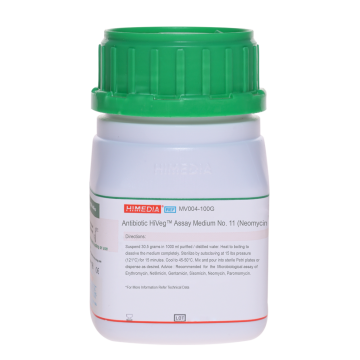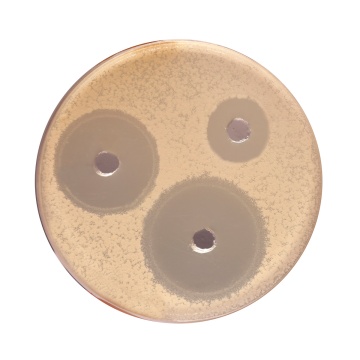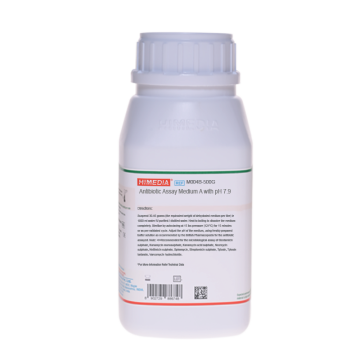 Your enquiry has been submitted
Your enquiry has been submitted
Antibiotic Assay Medium No.11 (Neomycin, Erythromycin Assay Agar) (Erythromycin Seed Agar)
Intended use
Recommended for microbiological assay of antibiotics.
Composition**
| Ingredients | Gms / Litre |
|---|---|
| Peptone | 6.000 |
| Tryptone | 4.000 |
| Yeast extract | 3.000 |
| HM peptone B# | 1.500 |
| Dextrose | 1.000 |
| Agar | 15.000 |
Final pH (at 25°C): 8.3±0.2
**Formula adjusted, standardized to suit performance parameters
# Equivalent to Beef extract
Directions
Suspend 30.5 grams in 1000 ml purified/distilled water. Heat to boiling to dissolve the medium completely. Sterilize by autoclaving at 15 lbs pressure (121°C) for 15 minutes. Cool to 45-50°C. Mix well and pour into sterile Petri plates or dispense as desired.
Advice:
Recommended for the Microbiological assay of Erythromycin, Netilmicin, Gentamicin, Sisomicin, Neomycin, Paromomycin.
Other Tests:
Cup plate method is carried out using B. pumilis / kanamycin and M. flaves / erythromycin
- Dilution : 16 mg Kanamycin in 10 ml distilled water
Stock: 1:10 dilution of above solution
| concentration | stock (ml) | Distilled water (ml) | zone of inhibition |
|---|---|---|---|
| 5 | 0.25 | 4.75 | 15 mm |
| 20 | 1.00 | 4.00 | 20 mm |
| 100 | 5.00 | 25 mm |
- Dilution : 9 mg Erythromycin in 10 ml distilled water
Stock: 1:10 dilution of above solution
| Concentration | stock (ml) | Distilled water (ml) | zone of inhibition |
|---|---|---|---|
| 5 | 0.25 | 4.75 | 22 mm |
| 10 | 0.50 | 4.50 | 32 mm |
| 100 | 5.00 | 41 mm |
Principle And Interpretation
Antibiotic Assay media are used in the performance of antibiotic assays. Grove and Randall have elucidated those antibiotic assays and media in their comprehensive treatise on antibiotic assays (1). Schmidt and Moyer have reported the use of antibiotic assay medium for the liquid formulation used in the performance of antibiotic assay (2). These media are recommended by USP (3) and FDA (4).
Nutrients and growth factors are supplied by the ingredients like peptone, tryptone, yeast extract and HM peptone B. Dextrose provides the carbon and energy source. Agar provides excellent medium for antibiotic diffusion and gives well-defined zones of inhibition. Higher pH provides the optimal conditions for activity of antibiotic and also supports the growth of the test organisms.
Freshly prepared plates should be used for antibiotic assays. Test organisms are inoculated in sterile seed agar pre-cooled to 40-45°C and spread evenly over the surface of solidified base agar. All conditions in the microbiological assay must be controlled carefully.
Type of specimen
Pharmaceutical preparations
Specimen Collection and Handling:
For pharmaceutical samples follow appropriate techniques for handling specimens as per established guidelines (3).
After use, contaminated materials must be sterilized by autoclaving before discarding.
Warning and Precautions :
Read the label before opening the container. Wear protective gloves/protective clothing/eye protection/ face protection. Follow good microbiological lab practices while handling specimens and culture. Standard precautions as per established guidelines should be followed while handling specimens. Safety guidelines may be referred in individual safety data sheets.
Limitations :
- Freshly prepared plates must be used or it may result in erroneous results.
Performance and Evaluation
Performance of the medium is expected when used as per the direction on the label within the expiry period when stored at recommended temperature.
Quality Control
Appearance: Cream to yellow homogeneous free flowing powder
Gelling: Firm,comparable with 1.5% Agar gel
Colour and Clarity of prepared medium: Light yellow coloured, clear to slightly opalescent gel forms in Petri plates
Reaction: Reaction of 3.05% w/v aqueous solution at 25°C. pH : 8.3±0.2
pH: 8.10-8.50
Cultural Response
Cultural characteristics was observed after an incubation at 35-37°C for 18-24 hours.
| Organism | Inoculum (CFU) | Growth | Recovery | Antibiotics assayed |
|---|---|---|---|---|
| Micrococcus luteus ATCC 9341 | 50-100 | luxuriant | >=70% | Erythromycin While assaying Tylosin, Tylosin, tartarate, Vancomycin hydrochloride, adjust the pH to8.0±.0.2 |
| Staphylococcus aureus ATCC 6538p (00195*) | 50-100 | luxuriant | >=70% | Kanamycin monosulphate, Kanamycin acid sulphate, Netilmicin sulphate |
| Staphylococcus epidermidis ATCC 12228 (00036*) | 50-100 | luxuriant | >=70% | Gentamicin, Neomycin, Netilmicin, Paromomycin, Sisomycin |
| Bacillus pumilis ATCC 14884 | 50-100 | luxuriant | >=70% | Chlortetracycline, Framycetin, Kanamycin sulphate |
| Bacillus subtilis subsp. spizizenii ATCC 6633 (00003*) | 50-100 | luxuriant | >=70% | Dihydrostreptomycin sulphate, Erythromycin estolate, Kanamycin monosulphate, Kanamycin acid |
| Bacillus subtilis NCTC 8236 | 50-100 | luxuriant | >=70% | Dihydrostreptomycin sulphate, Streptomycin sulphate |
| Bacillus subtilis NCTC 8241 | 50-100 | luxuriant | >=70% | Erythromycin estolate, Gentamicin sulphate |
*- Corresponding WDCM Numbers
Storage and Shelf Life
Store between 10-30°C in a tightly closed container and use freshly prepared medium. Use before expiry date on the label.
On opening, product should be properly stored dry, after tightly capping the bottle in-order to prevent lump formation due to the hygroscopic nature of the product. Improper storage of the product may lead to lump formation. Store in dry ventilated area protected from extremes of temperature and sources of ignition. Seal the container tightly after use.
Product performance is best if used within stated expiry period.
Disposal
User must ensure safe disposal by autoclaving and/or incineration of used or unusable preparations of this product. Follow established laboratory procedures in disposing of infectious materials and material that comes into contact with sample must be decontaminated and disposed of in accordance with current laboratory techniques (5,6).
Reference
- Grove and Randall, 1955, Assay Methods of Antibiotics Medical Encyclopedia, Inc, New York.
- Schmidt and Moyer, 1944; J. Bact, 47:199.
- The United States Pharmacopoeia-National Formulatory (USP-NF), 2022.
- Tests and Methods of Assay of Antibiotics and Antibiotic containing Drugs, FDA, CFR, 1983. Title 21, part 436, Subpart D, Washington, D.C. U.S Government printing office, paragraphs 436, 100-436, 106 pg 242-259 (April 1).
- Isenberg, H.D. Clinical Microbiology Procedures Handbook 2nd Edition.
- Jorgensen, J.H., Pfaller, M.A., Carroll, K.C., Funke, G., Landry, M.L., Richter, S.S and Warnock., D.W. (2015) Manual of Clinical Microbiology, 11th Edition. Vol. 1.
| Product Name | Antibiotic Assay Medium No.11 (Neomycin, Erythromycin Assay Agar) (Erythromycin Seed Agar) |
|---|---|
| SKU | M004 |
| Application/ Industry | Pharmaceutical |
| Product Type | Regular |
| Physical Form | Powder |
| Origin | Animal |
| Packaging type | HDPE |
| References | 1. Grove and Randall, 1955, Assay Methods of Antibiotics Medical Encyclopedia, Inc, New York. 2.Schmidt and Moyer, 1944; J. Bact, 47:199. 3.United States Pharmacopoeia 2018, US Pharmacopoeial Convention Inc, Rockville, MD 4.Tests and Methods of Assay of Antibiotics and Antibiotic containing Drugs, FDA, CFR, 198 3.Title 21, part 436, SubpartD, Washington, D.C. U.S Government printing office, paragraphs 436, 100-436, 106 pg 242-259 (April 1). 4.Isenberg, H.D. Clinical Microbiology Procedures Handbook. 2nd Edition. 5.Jorgensen,J.H., Pfaller , M.A., Carroll, K.C., Funke, G., Landry, M.L., Richter, S.S and Warnock., D.W. (2015)Manual of Clinical Microbiology, 11th Edition. Vol. 1. |
| Customized Product Available | No |








